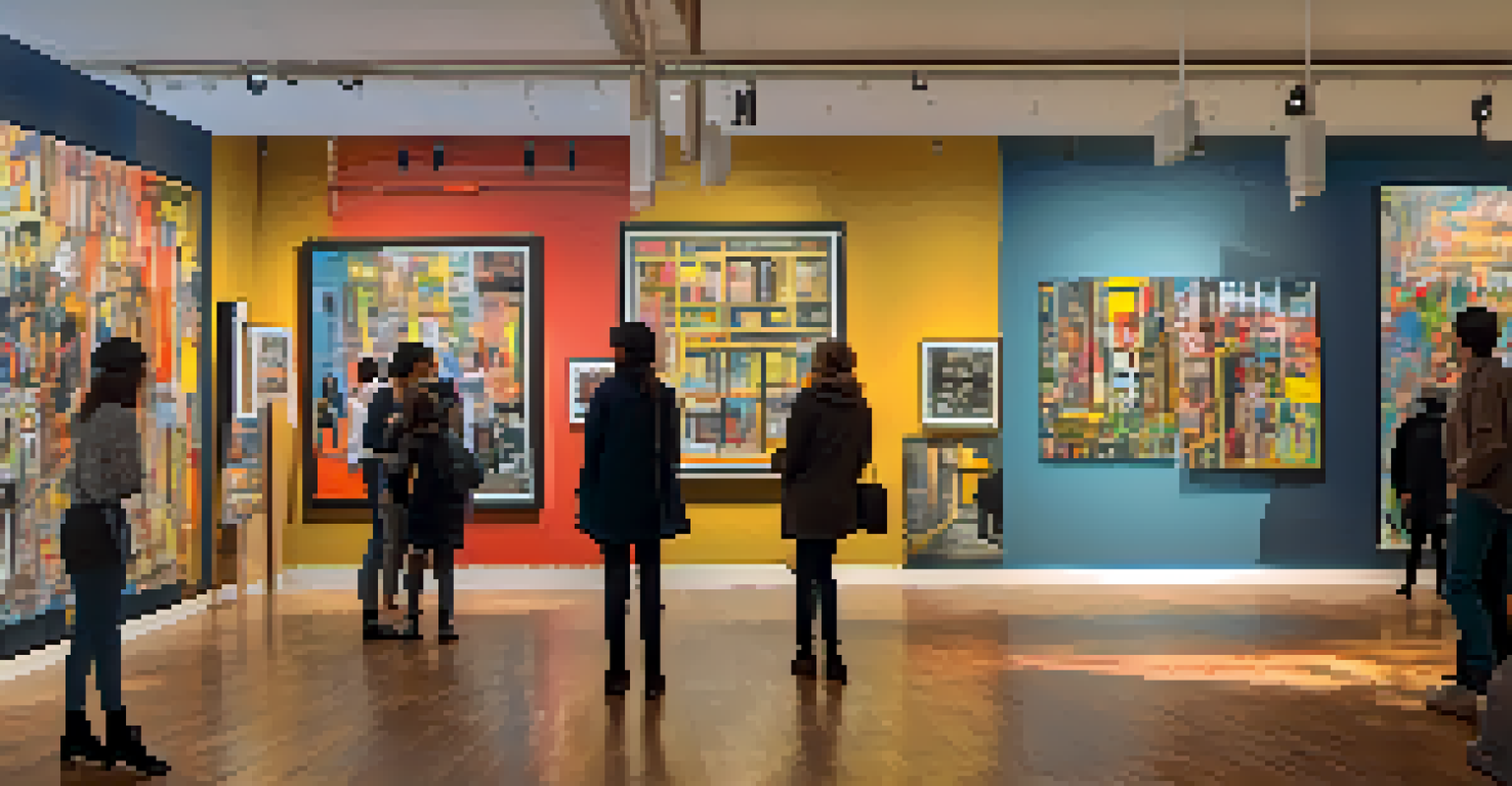The Dynamic Art of Jean-Michel Basquiat: A Neo-Expressionist Icon

Introduction to Jean-Michel Basquiat's Unique Style
Jean-Michel Basquiat emerged as a fascinating figure in the art world, known for his raw, expressive style. His art is a powerful mix of graffiti and neo-expressionism, characterized by bold colors and dynamic forms. Born in Brooklyn in 1960, Basquiat's multicultural background greatly influenced his artistic voice, infusing his work with themes of identity and race.
I don’t think about art when I’m working. I try to think about life.
One of the hallmarks of Basquiat's style is his use of text, often incorporating words and phrases that challenge societal norms. This combination of visual and verbal elements creates a dialogue within his pieces, inviting viewers to engage on multiple levels. His work reflects a deep understanding of the complexities of urban life, making it resonate with many audiences.
Basquiat's art is not merely for aesthetic pleasure; it’s a commentary on social issues, wealth disparity, and the struggle for recognition. By merging personal experiences with broader cultural narratives, he created a unique artistic language that still captivates viewers today.
The Influences Behind Basquiat's Work
Basquiat was heavily influenced by the vibrant street culture of New York City in the late 1970s and early 1980s. The graffiti movement, along with the burgeoning hip-hop scene, provided a fertile ground for his creativity to flourish. Artists like Andy Warhol and Keith Haring also played significant roles in shaping his artistic journey, offering new perspectives on contemporary art.

His Haitian and Puerto Rican heritage infused his work with cultural references, addressing themes of race, identity, and history. Basquiat often drew inspiration from African art and literature, which added depth to his pieces. This rich tapestry of influences helped him to create artworks that were both personal and universal, resonating with diverse audiences.
Basquiat's Art Reflects Identity Issues
Jean-Michel Basquiat's work intricately explores themes of race and identity, inviting viewers to engage with the complexities of urban life.
Moreover, the socio-political landscape of America during his lifetime provided a backdrop for his critiques. The rise of consumerism and the struggles of marginalized communities became recurring motifs in his art, allowing him to comment on the world around him with a bold and unflinching lens.
The Evolution of Basquiat's Artistic Career
Basquiat's artistic career began as a street artist, using the pseudonym 'SAMO' to tag his graffiti around Manhattan. This early work laid the groundwork for his later success, merging street culture with fine arts. His transition from the streets to galleries was meteoric, with his first major exhibition occurring just a few years after he started.
I am not a black artist, I am an artist.
Throughout the 1980s, Basquiat's work gained significant recognition, leading to collaborations with established artists like Andy Warhol. These partnerships not only elevated his profile but also showcased his versatility and willingness to experiment. His ability to navigate both the street art scene and the gallery world was a testament to his unique talent and vision.
However, his rise to fame was not without challenges. The pressures of the art world, combined with personal struggles, often took a toll on his mental health. Despite these obstacles, Basquiat continued to produce thought-provoking work until his untimely death in 1988.
Key Themes in Basquiat's Art
Basquiat's art is rich with themes that explore identity, race, and power dynamics. He often juxtaposed imagery and text to create a narrative that challenges societal norms and reflects his experiences as a Black artist in America. This layering of meaning invites viewers to unpack the complexities within each piece.
Another notable theme is the critique of capitalism and consumerism. Many of his works feature symbols of wealth and power, often presented in a way that critiques their value and impact on society. This duality in his work encourages a deeper reflection on what it means to succeed in a materialistic world.
Cultural Influences Shaped His Style
His multicultural background, combined with the vibrant street culture of New York, significantly influenced his artistic voice and themes.
Additionally, Basquiat frequently referenced historical figures and events, weaving them into his art to comment on the past's influence on the present. This approach not only honors his heritage but also makes a broader statement about history's cyclical nature and its relevance to contemporary issues.
Basquiat's Impact on Contemporary Art
Jean-Michel Basquiat's influence extends far beyond his lifetime, shaping the landscape of contemporary art in profound ways. His raw, unfiltered approach to art opened doors for future generations of artists to express themselves authentically. Basquiat's work continues to inspire a new wave of artists who draw from street culture and personal narratives.
Moreover, his ability to blend high and low art has shifted perceptions within the art community. By challenging traditional notions of what constitutes 'fine art,' Basquiat paved the way for a more inclusive and diverse art world. His legacy encourages artists to explore their identities and experiences without fear of judgment.
The resurgence of interest in his work, especially among younger audiences, highlights the timelessness of his themes. As society grapples with ongoing issues of race, identity, and socio-economic disparity, Basquiat's art remains a powerful reflection of these struggles.
The Legacy of Jean-Michel Basquiat
Jean-Michel Basquiat's legacy is one of resilience and innovation, leaving an indelible mark on the art world. His works continue to fetch record prices at auctions, underscoring the enduring value of his contributions. Museums and galleries worldwide celebrate his art, ensuring that his voice remains alive and relevant.
Beyond the art market, Basquiat's influence can be seen in various cultural spheres, including fashion, music, and film. His story resonates with many, highlighting the challenges faced by artists from marginalized communities. This narrative of struggle and triumph continues to inspire emerging artists to pursue their dreams.
Legacy of Innovation and Resilience
Basquiat's enduring impact on contemporary art highlights the importance of authentic self-expression and cultural dialogue in challenging societal norms.
Ultimately, Basquiat's art serves as a reminder of the power of creativity to provoke thought and inspire change. His dynamic expression and commitment to social commentary ensure that his work will be studied and celebrated for generations to come.
Conclusion: Celebrating Basquiat's Artistic Journey
In conclusion, Jean-Michel Basquiat's journey as an artist is a testament to the power of self-expression and the importance of cultural dialogue. His unique style and profound themes resonate deeply, inviting viewers to engage with the complexities of society. As we reflect on his work, we are reminded of the rich tapestry of influences that shape an artist's voice.
Basquiat's ability to navigate different artistic realms while staying true to his roots serves as an inspiration for aspiring artists everywhere. His legacy encourages us to embrace our individuality and to use art as a platform for social change. By celebrating his contributions, we honor not only his talent but also his vision for a more inclusive world.

As we continue to explore the dynamic art of Jean-Michel Basquiat, we recognize the lasting impact of his work on contemporary culture. His art remains a powerful force, challenging us to look beyond the surface and engage in meaningful conversations about identity, race, and the human experience.